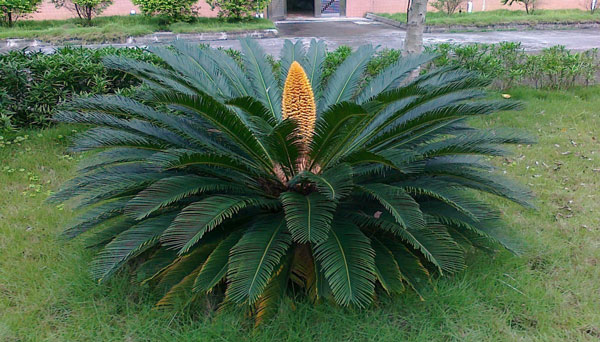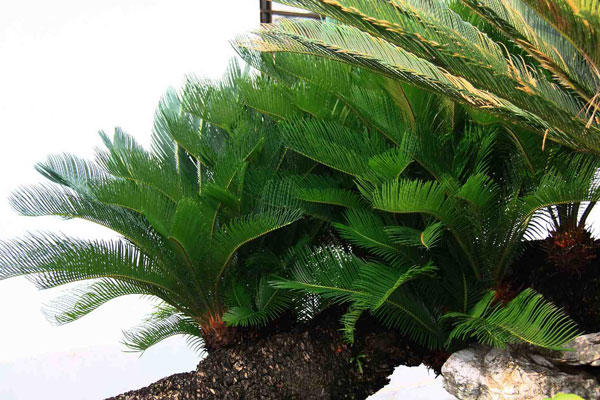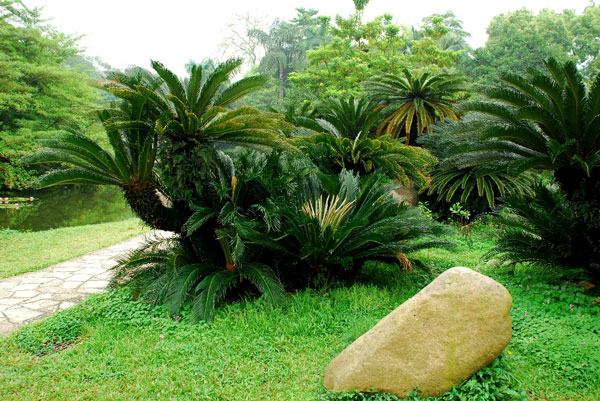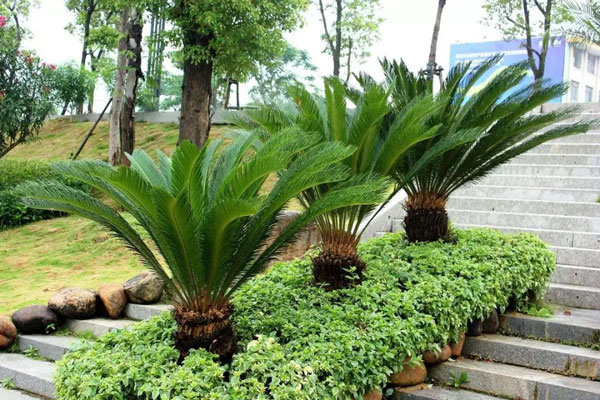Sago Palm (Cycas Revoluta) Grow & Care Guide
Written by Iris
Nov 03 2021

Sago Palm (Cycas revoluta) is a famous ornamental tree species. It has a long lifespan and a beautiful and generous appearance. Sago Palm has a quaint tree shape, a strong trunk, and hard as iron, showing a kind of toughness and strong vitality. In addition, the feather leaves of Sago palm are smooth and shiny, and are always green all year round, which has a good effect on beautifying the environment. In the south, it is mostly planted beside the courtyard or in the lawn, while in the north it is suitable for large potted plants to decorate courtyard houses and halls. It is very beautiful.
Be patient – they can take up to three months to germinate. Keep the soil moist, and when the sago palm seed germinates, you can remove the plastic wrap.
Keep in mind that pruning Sago Palm is only recommended for brown, dry fronds that have died. You may be tempted to remove yellowing fronds, particularly if you feel they ruin the green, lush appearance. Here's what I have to say to that: don’t! Removal of these fronds, especially when yellow portions are found towards the bottom of the plant, can actually cause stress. And this can lead to stunted growth, or make your Sago Palm susceptible to infection. Yellow fronds are still alive and absorbing nutrients, and removal may actually cause the problem to spread up the plant in cases where this is a sign of disease.
Over the years, as your sago palm matures, you may choose to prune Sago Palm into a tree form rather than a rounded bush with lower leaves that touch the ground. This must be done gradually over the course of years, in order to avoid undue stress. Remove the oldest fronds from the base sparingly, cutting as closely to the trunk as possible.
If you've ever had aphids take over your rose bushes, you’re probably familiar with the honeydew that they excrete, and the unsightly mold that can grow on your plants as a result. Scale bugs can cause similar issues when they attack your cycads.
Cycas rumphii (queen sago): This plant grows more like a tree than a shrub, reaching around 15 feet tall.
Cycas circinalis (queen sago palm): This plant also is tree-like, reaching around 10 feet tall, and is native to India.
Metroxylon sagu (true sago palm): Unlike Cycas revoluta, this plant is a true palm that’s part of the botanical family that contains other popular palm trees.
How to Propagate Sago Palm (Cycas revoluta)Sago Palm Propagation with SeedsSago Palm Propagation with DivisionHow to Grow Care for Sago Palm (Cycas revoluta)Sago Palm Light RequirementsSago Palm Soil CareSago Palm WateringSago Palm Temperature & Humidity CareSago Palm Fertilizer CareSago Palm Pruning CareSago Palm Pests & Diseases CareVarieties of Sago PalmSago Palm (Cycas revoluta) FAQHow Often Do Sago Palms Need to Be Trimmed?Is Sago Palm Toxic?
How to Propagate Sago Palm (Cycas revoluta)
Sago Palm Propagation with Seeds
You can propagate Sago Palm (Cycas revoluta) from seed. In a small pot, press the seed into the soil with the flat side up, keeping about one-third of the seed above soil level, and place the pot in a warm area. Plant one seed per pot, to give it room to grow. Tamp the soil down around the seed, water well, and cover the pot with plastic to create a mini-greenhouse that locks in warmth and moisture. sago palm seeds will germinate in temperatures of 70 to 100°F, so leave them in a warm, sunny location or use a heat mat.Be patient – they can take up to three months to germinate. Keep the soil moist, and when the sago palm seed germinates, you can remove the plastic wrap.
Sago Palm Propagation with Division
Sago Palm can be propagated via division, as well as growing Sago Palm by seed. For the first method, you may notice new clusters forming near the base of the plant. These pups can be cut off and planted elsewhere, or shared with fellow gardeners.- Don't procrastinate if you are going to attempt this process. Once the pups get too large, it's very difficult to successfully propagate Sago Palm. Get them before they're a foot tall.
- In the spring or fall, clear the dirt from around the base of each pup. Grasp the base of a pup and gently wiggle it to pop it off. If it has already grown too large, you may have to cut it off with a clean, sharp gardening knife.
- Pinch or cut off any leaves that are sprouting from the pup. Place separated pups in the shade for a week to heal the wound, then choose a pot that’s a couple inches larger in diameter than the pup.
- Fill the pot with a fast-draining blend of sand, perlite, and peat moss, or a container mix that’s suitable for palms. Dig a hole and place the pup in the hole with the wound side down.
- Water thoroughly, and let the soil dry out before watering again. Keep Sago Palm in the shade and away from bright sunlight until it has rooted, and note that this can take several months.

How to Grow Care for Sago Palm (Cycas revoluta)
Sago Palm Light Requirements
Sago Palm plant prefer to be in indirect but bright light for the majority of the day. You do want to avoid putting them in direct sunlight, especially during the summertime when the hot afternoon sun comes around. Doing so can result in burnt foliage and wilting. However, if they don’t get enough light, you can end up with very sparse foliage and an unhealthy plant. If you have this plant indoors, put it in a bright west, east, or south-facing window. You can move it outside once warmer weather hits, as long as you put it in a place with dappled light.Sago Palm Soil Care
Ideally, Sago Palm likes very well-draining but rich soil. Sandy and clay-based soil will not give you a healthy plant. You can add a lot of compost to the foot of your plant once or twice a year to help enrich it and encourage good drainage. Indoors, your ideal soil mixture is regular potting soil that you amend with peat moss, sand, or pumice to make it gritty.Sago Palm Watering
Any climate that gets at least 9 inches of rain a year will sustain a Sago Palm. In dry climates, however, Sago Palm needs moderate watering. During very warm, dry weather, keep your Sago Palm happy by deep-watering it every two weeks or so. Leave the hose on a very low drip and place it at the base of the tree. Leave it there for an hour or so to let the water penetrate down to the roots. Once the plant is well established, deep watering is not needed.Sago Palm Temperature & Humidity Care
Sago Palm plants love warm, humid conditions. They can briefly tolerate cold temperatures, but frost can damage the foliage, and temperatures below 20 degrees Fahrenheit will likely kill the plant. When growing Sago Palm indoors, protect your sago palm from drafts and airflow from heating and air-conditioning vents, which can cause extreme temperature fluctuations that can damage the plant.Sago Palm Fertilizer Care
An annual application of a balanced, slow-release fertilizer in spring usually supplies sufficient nutrients. Sprinkle about 1 tablespoon per square foot of a 10-10-10 fertilizer around the base of the Sago Palm, at least 8 inches from the plant, and water it in. Yellow foliage may indicate a potassium or magnesium deficiency in the soil. An application of a chelated iron spray to the foliage provides these necessary nutrients. The older foliage may remain yellow, but new foliage will grow in a healthy green.Sago Palm Pruning Care
Dead fronds can be removed with sanitized pruners. Remember to wear gardening gloves when you are doing this, to avoid jabs from the sharp, pointed leaf tips. To improve the look of the plant, you may also choose to carefully cut away withered fruit and flower stalks at the end of the season, for seed saving or disposal.Keep in mind that pruning Sago Palm is only recommended for brown, dry fronds that have died. You may be tempted to remove yellowing fronds, particularly if you feel they ruin the green, lush appearance. Here's what I have to say to that: don’t! Removal of these fronds, especially when yellow portions are found towards the bottom of the plant, can actually cause stress. And this can lead to stunted growth, or make your Sago Palm susceptible to infection. Yellow fronds are still alive and absorbing nutrients, and removal may actually cause the problem to spread up the plant in cases where this is a sign of disease.
Over the years, as your sago palm matures, you may choose to prune Sago Palm into a tree form rather than a rounded bush with lower leaves that touch the ground. This must be done gradually over the course of years, in order to avoid undue stress. Remove the oldest fronds from the base sparingly, cutting as closely to the trunk as possible.
Sago Palm Pests & Diseases Care
A few potential pests and problems that you may encounter when growing Sago Palm include scale insects, yellowing, sooty mold, and various types of rot.If you've ever had aphids take over your rose bushes, you’re probably familiar with the honeydew that they excrete, and the unsightly mold that can grow on your plants as a result. Scale bugs can cause similar issues when they attack your cycads.

Varieties of Sago Palm
There are other plants that use the common name of Sago Palm, though Cycas revoluta is the one that's most widely cultivated. The other species include:Cycas rumphii (queen sago): This plant grows more like a tree than a shrub, reaching around 15 feet tall.
Cycas circinalis (queen sago palm): This plant also is tree-like, reaching around 10 feet tall, and is native to India.
Metroxylon sagu (true sago palm): Unlike Cycas revoluta, this plant is a true palm that’s part of the botanical family that contains other popular palm trees.

Sago Palm (Cycas revoluta) FAQ
How Often Do Sago Palms Need to Be Trimmed?
The practice of trimming the Sago Palm is controversial in plant circles. My plant has spent many years between trimmings. It is only in the last few years that I have had time to maintain and trim the plant to my liking. New flushes of leaves sprout every year and I trim the plant every year. I enjoy my sago trimmed and kept slim.Is Sago Palm Toxic?
All parts of the Sago Palm are toxic to humans and animals when ingested, but the seeds (nuts) are the most toxic part. The toxin, called cycasin, attacks the liver causing a broad range of symptoms. If you have small children or pets, take care to keep this plant away from themLatest Updated
- Benefits of Bugleweed - 7 Science-backed Health Benefits
- Bugleweed Dangers & Side Effects - Is It Poisonous?
- How to Plant Evergreen Trees - What You Should Know
- When to Plant Evergreens - Grow Guide for Evergreen Trees
- 12 Wonderful Evergreen Shrubs for Your Garden
- 12 Popular Evergreen Plants with Pictures for Beginners
- When And How To Prune A Lilac Bush Like a Pro
- How to Grow & Care for Lilac Vine (Hardenbergia Violacea)
- Japanese Lilac Tree (Syringa Reticulata) Care & Propagation Guide
- Shumard Oak Pros and Cons - What to Know
Popular Articles
- Winter maintenance of Antirrhinum Majus
- How to Grow Terminalia Mantaly Tree
- How to Grow and Care for Crossostephium Chinense
- How to grow Antirrhinum Majus in spring
- Peristeria Elata (Dove Orchid) Profile: Info & Care Guide
- Underwatered Snake Plant (Sansevieria Trifasciata) - Signs And How To Fix
- How to Care for Brazilian Jasmine Plant (Mandevilla Sanderi)
- How to Grow & Care for Graptopetalum Purple Delight in Summer
- Rosa Chinensis (China Rose): Plant Growing & Care Tips
- How to Care for Baby Sun Rose (Aptenia Cordifolia)